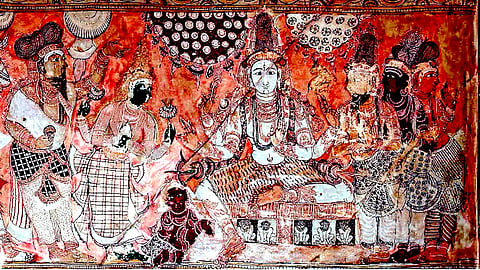- Commentary
- History Vignettes
- Notes on Culture
- Dispatches
- Podcasts
- Indian LanguagesIndian Languages
- Support

THE FABULOUSLY THRILLING LIBERATION OF Madurai from the hands of the cow-eating Turushka ruler sent waves of ecstasy throughout Hindus in south India. He had been decisively crushed, and the fabulous Meenakshi Sundareshwara Temple had been reclaimed. Its stately doors leading to Kailasa itself were reopened for the first time in half a century, and this is how the Hindus of Madurai celebrated the aeonian triumph:
During these Mahomedan days, in the Virodhi Samvatsara of the Salivahana Saka, the general of the King of Mysore, named Kampanudiaver, a native of Karnata, having conquered the Mahomedans, took possession of the kingdom of Madura. He opened the Siva and Vishnu temples, which had been locked-up throughout the country. He opened the Shiva temple at Madura; and obtained a personal view of the god. The general, seeing this grand sight was glad. He struck his eyes and with great piety made the customary offerings; he gave many villages to the temple, and many jewels and established ordinances for the regular performance of worship. The general, his son, and his son-in-law gave many jewels to the Siva and Vishnu temples, and ordered the sacred services to be con-ducted. Kumara Kampana had saved the honour of the land; and there is no wonder that the people call him by the name of the province from which he hailed—Kampana of Karnataka.
As we saw in the earlier episodes of this series, this is the power of true Hindu unity, grit, determination and decisiveness.
Madhurāvijayam, or the reclamation of Madurai established the House of Sangama as the new unchallengeable Hindu Empire, which had risen out of the ashes of the Turushka destructions. The vengeance that Hindus had been clamouring all along was finally achieved. By 1378-80, there was almost no trace of the Islamic menace in the Vijayanagara territory and the new empire of Hindu Dharma soared over south India like a massive protective fort with imposing towers and vigilant turrets, and Hindus willingly gave the Sangama Brothers their complete loyalty.
Dr. Saletore captures this epoch quite expressively:
It must be remembered that the indefatigable sons of Sangama threw upon the enemy a united front; and this concerted action had the double effect of silencing all opposition and of annihilating the forces of Islam, which took two and half centuries to combine again against Hindus. The one objective of the Sangama sons was the preservation of Hindu independence in South India…Vijayanagara stood as the visible embodiment of the national resistance to save the southern enclave for the Hindus and keep it free from being over- run by the Muhammadans. The common people realized that the honour of their homes and the destiny of the country were safe in the hands of the descendants of Sangama.
Thus, after nearly seventy years of terrible humiliation during which the whole of south India had been defiled by Islam, Hindus had finally burst out from the earth and heralded a glorious new era. The Vijayanagara monarchs instilled a fresh surge of confidence in Hindus and inspired them to win freedom from the alien rulers in order to protect their homes and women and children and to preserve their ancient Dharmic heritage unhindered. At the height of its glory, the Portuguese traveller Domingo Paes said this about Hindus:
In the Vijayanagara Empire, there were the finest young Hindu men to be ever seen or could be seen. AND AMONG ALL OF THEM, I DID NOT SEE A SINGLE MAN WHO WOULD ACT LIKE A COWARD. THEIRS WAS A TRADITION OF COURAGE AND DUTY.
Indeed, it is one thing to defeat the invading forces of Islam but it is entirely another thing to sustain the victory for centuries. This is perhaps the greatest legacy and gift of the Vijayanagara Empire to the Hindus of south India. As long as it was at the helm, no Muslim ruler from the north dared to look in the direction of south India. For about three centuries.
In fact, the Bahamani Muslim kings, the sworn enemies of Vijayanagara, lived in a constant dread of Vijayanagara. It is said that for an entire year after Sri Krishnadevaraya’s death, the Bahamani Sultans actually refused to believe that he was actually dead. They believed that even his ghost had the power to defeat them.
And now we come to the penultimate section of this series.
THE EXTRAORDINARY MILITARY VICTORIES, the well-oiled administration and the splendid wealth of the Vijayanagara Empire are all quite well-known. What is lesser known is the role of the Empire in rejuvenating and renewing Sanatana Dharma in a comprehensive sense.
A spirited and profound revival occurred in art, music, literature, poetry, painting, philosophy, in our traditions, customs, social etiquette and generally speaking, Hindu culture. This revival was so extraordinary and far-reaching that the successors of Vijayanagara—the Nayakas, the Palegars, etc., continued it till Indian democracy extinguished these states and principalities thereby killing their cultural continuity. The Vijayanagara legacy is still visible throughout south India and Hindus carry it subconsciously in their manners, while doing Puja, in undertaking Tirtha-Yatras, etc. The roots of the world-renowned Mysore Dasara go back to the Dasara celebrations initiated during the Vijayanagara Era. In fact, there is a direct connection between the Mahanavami Dibba in Hampi and Mysore Dasara. That is a period of half a millennium.
Finally, the singular role of the Vijayanagara Empire as the greatest embodiment of Hindu resistance to alien Islamic invasions is this: think of the fate of Sanatana Dharma in north India. Not a single Hindu temple of the classical period survives there.
Series concluded
The Dharma Dispatch is now available on Telegram! For original and insightful narratives on Indian Culture and History, subscribe to us on Telegram.
